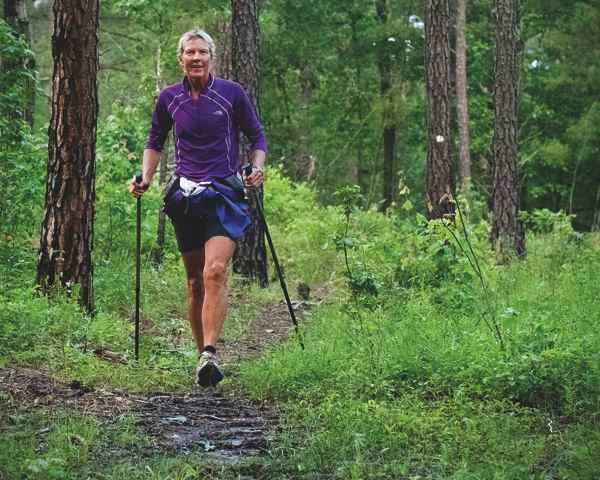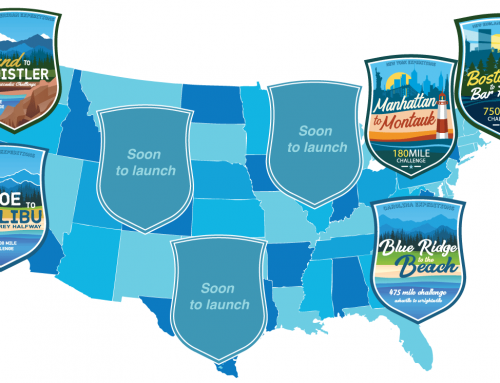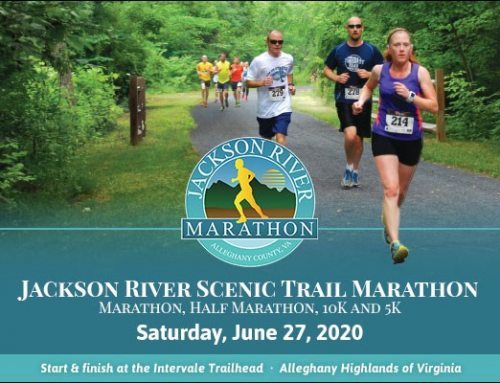
By Charlie Engle
I’m a North Carolina native and an avid trail runner so I know how wonderful and diverse this great state is … or at least I thought I did until I heard Diane Van Deren describe the sweet salty taste of the coastal air and the loamy aroma of the Great Smoky Mountains. I have been to these places often but somehow hearing about them from a visitor was like hitting the refresh button on my memory. It all came back to me powerfully through Diane’s passionate descriptions of the state I have known for most of 50 years.
Although Diane had spent only a little more than three weeks in the Tar Heel State, she was testifying to things that only a native should know. But Diane Van Deren is no beachcomber in flip flops or day hiker in trail shoes. Rather, she is an adventurer and a modern day explorer. So she didn’t just visit a few places, eat some barbeque or fried seafood, and check North Carolina off her to-do list. Instead, she ran across the state … the WHOLE state. For a thousand miles.
This inevitably painful idea started when the 52-year-old ultrarunner and North Face athlete came to North Carolina in October 2011. Diane traveled to Raleigh from the mountains of Colorado to share her miraculous story as part of The North Face “Never Stop Exploring” Speaker Series. After the event, Chuck Millsaps of the Great Outdoor Provision Co. approached Diane to congratulate her for giving such an impassioned presentation. GOPC was the event sponsor and the night had gone very well, raising much-needed funds for the North Carolina Mountains-to-Sea Trail (aka MST). Everyone was excited and the adrenaline was coursing like caffeine in a 6-year-old. It’s been my personal experience that many painful ideas are born in the slipstream of such high-energy nights, and this night was no exception.
Chuck introduced Diane to Kate Dixon, director of the Mountains-to-Sea Trail, and Kate casually mentioned that Matt Kirk, another ultrarunner, had recently run the nearly 1,000-mile length of the trail in record time. In that second, everything shifted for Diane, the same way a small earthquake can leave a tiny fissure, unseen to others but changing everything below the surface. Diane asked Kate how long it had taken Matt Kirk to run the trail. “About 24 days,” she replied. Mental gymnastics ensued and it didn’t take long for Diane and Chuck to hatch the idea of a record attempt of their own. Chuck is not known as the Minister of Culture for nothing, so he immediately saw that a record attempt by Diane could benefit the MST and give his team at GOPC a great and worthy project to work on. A little less than four months later, Diane was standing in the rain at the trailhead of the Mountains-to-Sea Trail wondering if this was really such a great idea. But she knew the time for wondering was over; it was now time to run.
The North Carolina Mountains-to-Sea Trail is an idea decades in the making. The trail snakes through the Great Smoky Mountains, meanders through the Piedmont and the Sandhills, then dips its tail in the ocean at the Outer Banks. It’s not so much one trail as it is a series of trails, connecting the highest peaks of the state to the rugged beauty of the ocean. Chuck says, “I feel that MST is one of North Carolina’s greatest treasures. Like the Appalachian Trail, this footpath has the potential to connect our state and the people who live here in a meaningful way for generations to come.” There are maps and books about the trail available at GOPC, but the information is ever changing as new sections of the trail are completed. At the moment, more than half of the trail is finished and these sections are connected by some less-than-elegant roads. For the latest information about MST, the best source is the folks that work at GOPC. Other adventurous people choose small chunks of the trail to hike, but Diane decided to bite off the whole thing at once and see what would happen.
Expeditions always sound fantastic during the planning phase. The world is full of possibilities and it seems that anything can be accomplished if it is thought out properly. Diane had a tremendous support team in place, mostly from Great Outdoor Provision Co., with Chuck heading up the logistics and Amy Hamm and Joel Fleming taking care of a hundred other details. They coordinated with The North Face to put together a backpack filled with the necessary gear for Diane to withstand the cold in the mountains, the wet in the Piedmont, and the humidity at the ocean. Great Outdoor Provision Co. has provided the backbone for many serious expeditions and for day hikes, too. Diane’s North Face pack included clothing, of course, but also important safety equipment. Water treatment tablets, headlamps, a SPOT GPS unit, laminated maps, and trekking poles were just a few of the needed items provided by GOPC.
No matter how much planning the team did, they couldn’t control the weather, so Diane began her record attempt in the fog, moving methodically away from Clingman’s Dome in the damp dark of early morning, sliding her feet over rocks that would quickly make a blistered mess of her toes. Blisters are a normal part of an ultrarunner’s existence and Diane has been logging more than her share of miles for many years. She is no stranger to suffering and has spent a lifetime running through hardship rather than away from it, suffering through some serious physical setbacks but never giving up. She’s a six-time finisher of the Hardrock 100, considered by many to be the toughest trail 100 in the world. She has done the Leadville 100 and has won both the 300- and 430-mile versions of the Yukon Arctic Ultra. For most runners, that kind of resume would provide more than enough reasons to sit in a rocking chair and tell stories of past greatness. But Diane was yearning for yet another challenge and the Mountains-to-Sea Trail presented itself right on time as the next barrier to push through.
The first days of the expedition nearly crushed the entire team physically. The rain wasn’t just wet, it was cold. Feet weren’t just sore, they were blistered and bleeding. Diane lives high in the Colorado mountains, where the climbs are steep but the air is dry and crisp when it’s not snowing. North Carolina’s Great Smoky Mountains were giving her far more of a challenge than she had expected.
Every expedition is filled with endless problems to solve. First Diane needed to fix her feet. Even though she had never experienced this level of foot problems, she was reluctant to change her habit of hiding blisters under layers of duct tape, choosing to cover rather than treat the fluid-filled invaders. Many veteran runners decide to suffer through the pain and deal with the consequences after the run is over. But this run was 1,000 miles and she needed to fix her feet immediately or she might not make it to the end.
Diane’s crew suggested that she see a doctor after a particularly brutal trek through Linville Gorge and Wilson Creek. She was having none of it. She continued on to slightly more manageable terrain, but even more rain dogged her for another couple of days, forcing her to allow her team to implement a new “system” of blister control. The goal was aimed more at keeping the feet dry than treating the blisters. Dry feet can heal but wet feet never will. Diane had always fought through the tough times. But this time was different. This time, there would be no continuing if she did the same old thing. So she fought her instincts and tried something new.
Crew chief Amy Hamm focused on keeping Diane’s feet dry. She removed the duct tape, which was just making things worse, and replaced it with bandages that were meant to protect but also to keep the feet as dry as possible. She felt good about her solution but nevertheless worried as she sent Diane down the trail once again, promising to meet her a few miles later to see how things were going. The crew could tell that Diane was worried too. If things got much worse, the entire expedition could be in jeopardy. All of the planning and the goals to raise money for the MST could be gone in an instant if she couldn’t continue. All of the crew would be let down too. They had left their families and their comfortable offices to come out here for what? A few days of rainy hiking? Hardly.
Like a good boxer, Diane tends to be at her best after taking a couple of hard punches to the gut. So it was no surprise when she pushed through the first days of punishment with even more determination than ever, despite her battered feet. This is where teamwork and optimism paid off. The moments of doubt were shoved aside for the team as Diane emerged from an eight-mile section with a giant smile on her face and a bounce in her step. The new blister system was working and the terrain had eased up just enough to allow for some recovery. They were still in business.
Chuck marveled at the disparity between Diane’s positive attitude and her willingness to suffer physically. “She is able to disconnect her pain like nobody I have seen before,” he said. For a runner, this ability is both a blessing and a curse. Ultimately, the way to get past pain is to keep moving forward, even when it hurts. The suffering would not stop until the journey ended, but Diane knew that when she started.
The expedition continued into the Piedmont region, finding flatter terrain but more traffic on the connecting roads between sections of the trail. The rain had stopped for the time being and this allowed Diane’s feet to continue healing and her spirit to stay afloat despite the physical punishment. Sleep deprivation was another part of the package as Diane slept only a few hours per night, somehow emerging from her tent with a smile each morning. One of the traits that makes Diane successful is her ability to remain positive and to encourage others even when she is feeling lousy. Her crew was amazed at her uplifting attitude and this helped to keep them motivated too. After all, it’s hard to complain as a crew member when your runner is upbeat and grinning.
One day rolled into the next, with miles piling upon miles until the team could almost taste the fried shrimp and hush puppies waiting for them at the beach. Day 21 provides a glimpse of the emotional highs that come with nearing the finish line. It was May 29, Memorial Day, and Diane was hoping to finish the next day. As the expedition neared completion, more and more runners were coming out to offer support in every imaginable way. Annette Bednosky, an amazingly accomplished ultrarunner in her own right, was pacing Diane through much of the day, just as she had on several previous days. Annette’s presence was crucial, bringing with it comfort and the solidarity that can only be found on the trails through shared suffering.
But that day’s highlight, and maybe the highlight of the entire expedition, was the section that Diane shared with Tom Hurd, a United States Army Special Forces veteran who chose to spend Memorial Day honoring Diane by helping her accomplish her goal. The experience was deeply moving, not only for the two runners but for everyone involved in the project. Chuck spoke of the day this way: “Knowing that Diane’s own son served in the military, I knew the day would be emotion-packed. What I wasn’t prepared for was the scene of Diane and Tom running through New Bern’s highly decorated National Cemetery at sunset. There was not a dry eye among the crew.”
There is something about an expedition that is surreal, but not in the disconnected way that many unusual events happen. After weeks on the trail, shedding the baggage that we all carry in our daily lives, the real and true spirit of a person is revealed. That is the beauty of voluntary hardship; if one can get through to the other side of the suffering, incredible things are just waiting to be discovered. For Diane, this was never truer than when she and the entire crew gathered together a mere three miles from Jockey’s Ridge, the finishing point for the expedition. The group joined hands and prayers of gratitude were offered; gratitude for each other, gratitude for the beauty of North Carolina, and gratitude for having accomplished a goal of monumental proportions. Diane and Chuck then covered the final three miles together, taking their time, trying to absorb the enormity of the project and the beauty of the moment.
“That is the hardest thing I have ever done,” Diane told a small gathering on the dune. “The only way I was able to do it was because of my team.” She then pulled them together for a group shot: Chuck, Kate Dixon, support crew chief Joel Fleming, and trail guides Sarah Millsaps, Russell Burke, and Christian Johnstone.
Diane did indeed set a new record by covering the nearly 1,000-mile distance of the North Carolina Mountain-to-Sea Trail in 22 days, 5 hours and 3 minutes. But that is really only a small part of the story. Her run showed that determination and sheer stubbornness can overcome any obstacle. It also serves as a reminder that we are truly lucky in this great state to have so much beauty and diversity so easily accessible. All one needs is a desire to explore and an openness to learn. And a good map would certainly help. The next step is just right out your front door.






